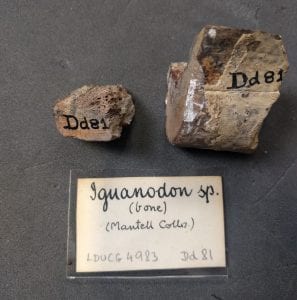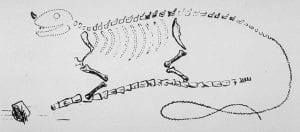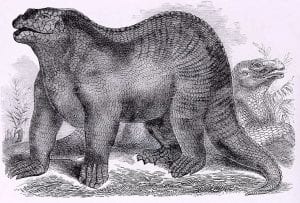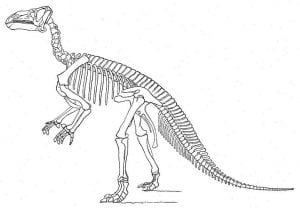Specimen of the Week 302: Gideon Mantell’s Iguanodon bones
By ucwehlc, on 28 July 2017
The specimen this week might be small, but it’s pretty important in the history of natural history. These two little pieces of fossil bone are from the collection of the early 19th century surgeon and palaeontologist Gideon Mantell. Specimen of the week is…
**Gideon Mantell’s Iguanodon bones**
Toothy Discovery
In 1822 some teeth were discovered in a quarry in Tilgate Forest, Sussex. Some sources say Gideon Mantell found them, some credit his wife Mary Ann, who illustrated many of his books and papers. Either way, Gideon Mantell realised the teeth were unusual, and during a trip to the Hunterian Museum at the Royal College of Surgeons he discovered they were similar to the teeth of an iguana. When his paper to the Royal Society was published in 1825 ‘Iguanodon’ became only the second dinosaur to be described by scientists.
Iguanodons at the Grant Museum
Most of Mantell’s fossils were either sold to the Natural History Museum in London, or were taken to New Zealand after Mantell’s death by his son Walter. So how did our little specimens end up in the Grant Museum? Mantell’s diaries give us a clue. It seems he was quite friendly with Robert Grant, the first curator of what is now the Grant Museum of Zoology. In February 1836 Mantell visited Grant at ‘the University of London’ to measure a crocodile, and it seems they often visited each other for tea or breakfast and attended one another’s lectures. There is even a mention of returning bones to Dr Grant, so we know that they exchanged specimens. It seems likely that our specimens were donated to Grant by Mantell himself.
Heavy duty herbivores
Mantell’s Iguanodons were herbivores that lived during the early Cretaceous, around 140-120 million years ago. They were around 10m long and weighed 4-5 tons. They could move around on two feet or four feet, and had a distinctive thumb spike, which palaeontologists believe was used for feeding and/or defence.
What’s in a name?
Science never stands still and the names of the species in the group Iguanodontia have been revised by palaeontologists several times. According to the most recent research the two species that Mantell discovered are now called Therosaurus anglicus and Mantellodon carpenteri, and the only species that bears the name Mantell coined is Iguanodon bernissartensis, from Belgium. This may come as a surprise to several generations of dinosaur-obsessed school children, and I can’t help but think that Mantell would be a little disappointed.
More reinventions than Lady Gaga
Our understanding of what Iguanodon (and Mantellodon and Therosaurus) looked like has also changed dramatically over the centuries as more and more fossil evidence has been discovered. Mantell initially belived Iguanodon looked like a giant iguana with a nose spike, though he later changed his mind when he found evidence it had heavy back legs and smaller forelegs.
Richard Owen interpreted it as a chunky rhino-style quadruped, and this was the version immortalised by Benjamin Waterhouse Hawkins in the Crystal Palace dinosaurs.
In the late 19th century discovery of more complete skeletons let to a new theory that Iguanodon was a bipedal animal, with a kangaroo-like posture and the spike on the thumb rather than the nose.
However, research in the 20th century shows Iguanodon walked mostly on four legs with its tail held in a stiff horizontal posture. Who knows what we might discover about these dinosaurs in the future, and what the next Iguanodon makeover might look like.
Hannah Cornish is the Curatorial Assistant at the Grant Museum of Zoology
3 Responses to “Specimen of the Week 302: Gideon Mantell’s Iguanodon bones”
- 1
-
2
Specimen of the Week 304: Fossil Box 12 | UCL Museums & Collections Blog wrote on 11 August 2017:

[…] and for research. Some of these specimens have already made their social media debuts such as Gideon Mantell’s Iguanodon bones and several fossil fish featuring on the Underwhelming Fossil Fish of the Month […]
-
3
Honora Renwick wrote on 25 May 2018:
Mantell’s diary credits his wife with the find but later on he claimed to have found the teeth. As we say in New Zealand, Yeah Right!
 Close
Close








[…] on from last week’s Specimen of the Week with a rockstar* connection, this month’s underwhelming fossil fish also has a famous connection, […]